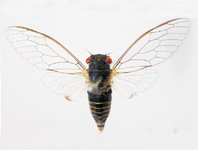Abstract
The Pauropsalta annulata Goding & Froggatt species group is distributed (widely) in eastern Australia. This group comprises P. annulata, P. rubristrigata (Goding and Froggatt) and P. ayrensis Ewart, with P. annulata sens. lat. containing the greatest diversity in calling songs, ecology and distribution. Previous studies have revealed that this diversity is due to the presence of several cryptic species, which together make up the Pauropsalta annulata species complex. The present study provides a revision of the Pauropsalta annulata species group and includes redescriptions of P. annulata s.str., P. rubristrigata (Goding & Froggatt) and P. ayrensis Ewart, as well as descriptions of 11 species new to science: P. blackdownensis sp. nov., P. corymbiae sp. nov., P. decora sp. nov., P. granitica sp. nov., P. inversa sp. nov., P. kobongoides sp. nov., P. notialis sp. nov., P. simplex sp. nov., P. subtropica sp. nov., P. torrensis sp. nov. and P. tremula sp. nov. In addition, two new subspecies are also described: P. n. notialis subsp. nov. and P. n. incitata subsp. nov., along with extensive areas of hybridisation, which justifies their subspecific status. Within the P. annulata species group, the P. annulata species complex is redefined to contain P. annulata s. str., P. notialis sp. nov. and P. tremula sp. nov. These species have a number of apomorphies in common and are expected to have had a single point of origin (i.e. represent a monophyletic group). To facilitate the identification of taxa in the P. annulata species group, separate keys are provided for specimens and field recordings based on morphology and calling song structure respectively. Morphological descriptions or diagnoses and descriptions of calling song structure are provided for each species and subspecies (and the hybrids between the subspecies). The descriptions are followed by a comprehensive statistical analysis of calling song specificity in the P. annulata species complex. A preliminary molecular phylogenetic analysis, focusing on species-level relationships and divergence times within the P. annulata species group, is also included.

